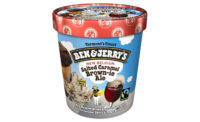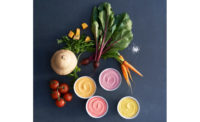Based on a McKinsey survey, most people still consume dairy, and a very small amount consume alternatives exclusively. Even though there’s been overall growth for plant-based alternatives, the market has seen recent areas of decline with consumers leaving categories, like plant-based creamers, yogurt, cheese, and ice cream.
What does this mean? Loyalty in the dairy category is mixed, with a large majority of U.S. consumers still only consuming dairy, proving its stronghold on people who purchase in this category. To further nail this point, approximately 90% of consumers do not plan to reduce dairy product consumption over the next three years.
Are dairy alternatives still on trend, important, and beneficial? Yes. However, there's a broader world of innovation that deserves recognition. Consumers are looking for something unique – maybe it’s Baskin-Robbins’ Chick'n & Waffles Ice Cream or maybe it’s a new international cheese at the local grocery store to add to the charcuterie board. New products and strong competition are all clamoring for the best seat at the table.
Why it’s on trend: Health, wellness, and ethical
Today’s health-conscious consumer is seeking dairy products that align with their current dietary goals. The typical American adult consumes 77 grams of sugar daily, which exceeds the recommended intake by over 3x. On a good note, 7 out of 10 individuals also say they’re willing to exchange their favorite snack for a low-sugar alternative, according to the American Heart Association.
Consumers are also increasingly seeking mood-enhancing dairy products. Research published in the National Library of Medicine shows that certain dairy ingredients, like whey protein, may have a positive impact on mood and stress response. Additionally, the probiotic content in fermented dairy products like kefir, skyr, labneh, and quark is gaining attention for their potential gut health benefits.
Modern consumers are also interested in ingredient origins, labeling, and ethical sourcing. The FDA's latest guidance on plant-based beverages represents a step in the right direction, but it still falls short. While it requires that plant-based beverages disclose nutritional differences in comparison to traditional milk, permitting them to label themselves as "milk" still risks misleading consumers, potentially damaging trust in these brands.
Good intentions and interest doesn’t always result in a purchase
While it’s still important for CPG brands in the dairy category to adapt to these health and wellness trends through reformulation or introduction of new products, other factors are just as important. Quality, price, packaging, and color – just to name a few.
However, when consumers choose dairy products, taste is the most important factor. Multiple surveys by the International Food Information Council Foundation consistently show this, with 88% consumers stating taste as their primary reason for buying a product. Price (70%), healthfulness (60%), convenience (52%), and sustainability (34%) were the other areas of focus. These numbers make it clear that focusing on taste during product development and using it as a key factor for product testing prior to launch is crucial.
Beyond plant-based
Traditional dairy products and experiences have an enduring allure for dairy-seeking consumers. Traditional dairy provides a broad consumer appeal and a sense of comfort and familiarity that resonates and impacts on purchase decisions. The reason? 41% of consumers say they choose comfort foods to bring happiness.
Traditional dairy products have also stood the test of time, perfected over generations, and earned the trust of consumers. When brands can focus on the authenticity of dairy products, they can tap into trust, assuring consumers of quality and tradition.
Across the diverse landscape of dairy products, it still remains crucial to shift the spotlight beyond plant-based alternatives. Artisanal and premium dairy products provide a shift to craftsmanship and taste, while ancient dairy ingredients and unique milk sources weave an authentic story around deep history and cultural roots. Also, texture and mouthfeel sensations can be explored to enhance the eating experience, while flavor fusions and global influences can influence consumer motivations to purchase.
Importance of product testing and consumer insights
Product testing and consumer insights play a pivotal role in guiding CPG dairy brands through the product development process. With the goal to create and launch successful products tailored to consumer needs and preferences, product testing methods like sensory evaluations and focus groups through a CLT or home-use testing process will be critical to success.
Furthermore, to mitigate risks and avoid costly failures, brands can conduct small-scale pilot tests, competitive analysis, shelf-life testing, and more. Customer feedback, social media listening, and product testing with a diverse range of consumer groups can also help brands dive deep into the heart of the consumer which can build brand loyalty and trust.
To stay ahead in the game, product testing must be seamlessly integrated into the product development process. Consumer expectations around dairy or dairy alternatives are getting higher, and competition is getting stronger. Brands are working with flavor and mouthfeel technologies to enhance experiences and replicate the texture and aroma of real dairy products. Testing products prior to launch can minimize risks and save on costs when real product users can speak their minds and manufacturers can create solutions for their unmet needs.
Subject matter experts, brand loyalists, category users, and potential users can group together with product developers to unveil motivations, benefits, favored attributes, pain points, and much more. These solutions are brought to the development table to enhance and refine products. The result is a truly desired product on the shelf, created by the consumer and made for the consumer. That is true innovation.
Future trends in dairy foods
The future of the dairy industry is poised for growth, helping brands grow stronger market share through the dynamics of product testing. Tech-driven personalization in dairy products is set to gain momentum with stronger data analytics and AI to create unique dairy experiences. Gastronomy-inspired creations will push the boundaries of flavor and texture, calling for product testing to balance culinary creativity with mass production. Meanwhile, unique limited editions that speak to exclusivity and intrigue will capture more consumer attention. We will also see future dairy trends continuing to align with evolving lifestyles, offering convenient, health-conscious, and plant-based options with a dual focus on both indulgence and well-being. Ultimately, product testing remains the compass that guides dairy brands toward success.
With anticipation of a dynamic future for dairy products, brands need to innovate by backing their products up with solid product testing to ensure quality and consumer satisfaction. The future of dairy products holds the promise of delighting our palates and enriching our lives in ways yet to be imagined.
This article presents views of the author only and may not represent views expressed by Dairy Foods or its parent, BNP Media.
Photo courtesy of Curion.




